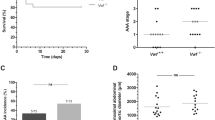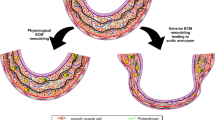Abstract
The renin-angiotensin system has been invoked in the development of both abdominal and thoracic aortic aneurysms. This has been demonstrated experimentally by the chronic subcutaneous infusion of angiotensin II, which consistently leads to development of abdominal aortic aneurysms (AAAs) in mice. Angiotensin II-induced AAAs have highly heterogenous cellular and extracellular matrix characteristics throughout the aorta that change markedly with infusion duration. The mechanistic basis for the reproducible location of AAA development has not been elucidated, but many insights have been provided, especially regarding receptor and inflammatory mechanisms. A recent clinical study provided limited evidence for extrapolating these results to mechanisms of human AAAs. Experimental evidence has also demonstrated that antagonism of angiotensin II type 1 (AT1) receptors prevents ascending aortic aneurysms in a murine model of Marfan’s syndrome. A clinical study is currently ongoing to demonstrate the efficacy of AT1 receptor antagonism in humans.
Similar content being viewed by others
References and Recommended Reading
Golledge J, Muller J, Daugherty A, Norman P: Abdominal aortic aneurysm. Pathogenesis and implications for management. Arterioscler Thromb Vasc Biol 2006, 26:2605–2613.
Ramirez F, Dietz HC: Marfan syndrome: from molecular pathogenesis to clinical treatment. Curr Opin Genet Dev 2007, 17:252–258.
Daugherty A, Cassis L: Angiotensin II and abdominal aortic aneurysms. Curr Hypertens Rep 2004, 6:442–446.
Daugherty A, Cassis LA: Mouse models of abdominal aortic aneurysms. Arterioscler Thromb Vasc Biol 2004, 24:429–434.
Daugherty A, Cassis L: Chronic angiotensin II infusion promotes atherogenesis in low density lipoprotein receptor-/-mice. Ann N Y Acad Sci 1999, 892:108–118.
Daugherty A, Manning MW, Cassis LA: Angiotensin II promotes atherosclerotic lesions and aneurysms in apolipoprotein E-deficient mice. J Clin Invest 2000, 105:1605–1612.
Wang YX, Martin-McNulty B, Freay AD, et al.: Angiotensin II increases urokinase-type plasminogen activator expression and induces aneurysm in the abdominal aorta of apolipoprotein E-deficient mice. Am J Pathol 2001, 159:1455–1464.
Ishibashi M, Egashira K, Zhao Q, et al.: Bone marrow-derived monocyte chemoattractant protein-1 receptor CCR2 is critical in angiotensin II-induced acceleration of atherosclerosis and aneurysm formation in hypercholesterolemic mice. Arterioscler Thromb Vasc Biol 2004, 24:e174–e178.
Gavrila D, Li WG, McCormick ML, et al.: Vitamin E inhibits abdominal aortic aneurysm formation in angiotensin II-infused, apolipoprotein E-deficient mice. Arterioscler Thromb Vasc Biol 2005, 25:1671–1617.
Zhou Y, Chen R, Catanzaro SE, et al.: Differential effects of angiotensin II on atherogenesis at the aortic sinus and descending aorta of apolipoprotein-E-deficient mice. Am J Hypertens 2005, 18:486–492.
Ayabe N, Babaev VR, Tang Y, et al.: Transiently heightened angiotensin II has distinct effects on atherosclerosis and aneurysm formation in hyperlipidemic mice. Atherosclerosis 2006, 184:312–321.
Eagleton MJ, Ballard N, Lynch E, et al.: Early increased MT1-MMP expression and late MMP-2 and MMP-9 activity during Angiotensin II induced aneurysm formation. J Surg Res 2006, 135:345–351.
Yoshimura K, Aoki H, Ikeda Y, et al.: Regression of abdominal aortic aneurysm by inhibition of c-Jun N-terminal kinase. Nat Med 2005, 11:1330–1338.
Cao RY, Adams MA, Habenicht AJ, Funk CD: Angiotensin II-induced abdominal aortic aneurysm occurs independently of the 5-lipoxygenase pathway in apolipoprotein E-deficient mice. Prostaglandins Other Lipid Mediat 2007, 84:34–42.
Ahluwalia N, Lin AY, Tager AM, et al.: Inhibited aortic aneurysm formation in BLT1-deficient mice. J Immunol 2007, 179:691–697.
Vinh A, Gaspari TA, Liu HB, et al.: A novel histone deacetylase inhibitor reduces abdominal aortic aneurysm formation in angiotensin II-infused apolipoprotein E-deficient mice. J Vasc Res 2007, 45:143–152.
Deng GG, Martin-McNulty B, Sukovich DA, et al.: Urokinase-type plasminogen activator plays a critical role in angiotensin II-induced abdominal aortic aneurysm. Circ Res 2003, 92:510–517.
Manning MW, Cassis LA, Huang J, et al.: Abdominal aortic aneurysms: fresh insights from a novel animal model of the disease. Vasc Med 2002, 7:45–54.
Henriques TA, Huang J, D’souza SS, et al.: Orchiectomy, but not ovariectomy, regulates angiotensin II-induced vascular diseases in apolipoprotein E deficient mice. Endocrinology 2004, 145:3866–3872.
Saraff K, Babamusta F, Cassis LA, Daugherty A: Aortic dissection precedes formation of aneurysms and atherosclerosis in angiotensin II-infused, apolipoprotein E-deficient mice. Arterioscler Thromb Vasc Biol 2003, 23:1621–1626.
Barisione C, Charnigo RJ, Howatt DA, et al.: Rapid dilation of the abdominal aorta during infusion of angiotensin II detected by noninvasive high frequency ultrasound. J Vasc Surg 2006, 44:372–376.
Rateri DL, Howatt DA, Xie X, et al.: Prolonged infusion of angiotensin II promotes abdominal aortic aneurysm remodeling associated with adventitial macrophage recruitment. Arterioscler Thromb Vasc Biol 2008, submitted.
Powell JT, Brady AR: Detection, management, and prospects for the medical treatment of small abdominal aortic aneurysms. Arterioscler Thromb Vasc Biol 2004, 24:241–245.
Liao S, Miralles M, Kelley BJ, et al.: Suppression of experimental abdominal aortic aneurysms in the rat by treatment with angiotensin-converting enzyme inhibitors. J Vasc Surg 2001, 33:1057–1064.
Furubayashi K, Takai S, Jin D, et al.: The significance of chymase in the progression of abdominal aortic aneurysms in dogs. Hypertens Res 2007, 30:349–357.
Daugherty A, Manning MW, Cassis LA: Antagonism of AT2 receptors augments angiotensin II-induced abdominal aortic aneurysms and atherosclerosis. Br J Pharmacol 2001, 134:865–870.
Cassis LA, Rateri DL, Lu H, Daugherty A: Bone marrow transplantation reveals that recipient AT1a receptors are required to initiate angiotensin II-induced atherosclerosis and aneurysms. Arterioscler Thromb Vasc Biol 2007, 27:380–386.
Cassis LA, Helton MJ, Howatt DA, et al.: Aldosterone does not mediate angiotensin II-induced atherosclerosis and abdominal aortic aneurysms. Br J Pharmacol 2005, 144:443–448.
Daugherty A, Ravisankar P, Szilvassy SJ, et al.: Angiotensin II infusion promotes ascending aortic aneurysms: attenuation by CCR2 deficiency. Arterioscler Thromb Vasc Biol 2008, submitted.
Gitlin JM, Trivedi DB, Langenbach R, Loftin CD: Genetic deficiency of cyclooxygenase-2 attenuates abdominal aortic aneurysm formation in mice. Cardiovasc Res 2007, 73:227–236.
King VL, Trivedi D, Gitlin JM, Loftin CD: Selective cyclooxygenase-2 inhibition with celecoxib decreases angiotensin II-induced abdominal aortic aneurysm formation in mice. Arterioscler Thromb Vasc Biol 2006, 26:1137–1143.
Zhang LN, Velichko S, Vincelette J, et al.: Interferon-beta attenuates angiotensin II-accelerated atherosclerosis and vascular remodeling in apolipoprotein E deficient mice. Atherosclerosis 2007, Epub ahead of print.
Manning MW, Cassis LA, Daugherty A: Differential effects of doxycycline, a broad-spectrum matrix metalloproteinase inhibitor, on angiotensin II-induced atherosclerosis and abdominal aortic aneurysms. Arterioscler Thromb Vasc Biol 2003, 23:483–488.
Wen J, Wang P, Smith SV, et al.: Syndecans are differentially expressed during the course of aortic aneurysm formation. J Vasc Surg 2007, 46:1014–1025.
Jiang F, Jones GT, Dusting GJ: Failure of antioxidants to protect against angiotensin II-induced aortic rupture in aged apolipoprotein (E)-deficient mice. Br J Pharmacol 2007, 152:880–890.
Thomas M, Gavrila D, McCormick ML, et al.: Deletion of p47phox attenuates angiotensin II-induced abdominal aortic aneurysm formation in apolipoprotein E-deficient mice. Circulation 2006, 114:404–413.
Gavazzi G, Deffert C, Trocme C, et al.: NOX1 deficiency protects from aortic dissection in response to angiotensin II. Hypertension 2007, 50:189–196.
Wang YX, Martin-McNulty B, da Cunha V, et al.: Fasudil, a Rho-kinase inhibitor, attenuates angiotensin II-induced abdominal aortic aneurysm in apolipoprotein E-deficient mice by inhibiting apoptosis and proteolysis. Circulation 2005, 111:2219–2226.
Martin-McNulty B, Tham DM, da Cunha V, et al.: 17 beta-estradiol attenuates development of angiotensin II induced aortic abdominal aneurysm in apolipoprotein E deficient mice. Arterioscler Thromb Vasc Biol 2003, 23:1627–1632.
Fatini C, Pratesi G, Sofi F, et al.: ACE DD genotype: a predisposing factor for abdominal aortic aneurysm. Eur J Vasc Endovasc Surg 2005, 29:227–232.
Yeung JM, Heeley M, Gray S, et al.: Does the angiotensin-converting enzyme (ACE) gene polymorphism affect rate of abdominal aortic aneurysm expansion? Eur J Vasc Endovasc Surg 2002, 24:69–71.
Claridge MW, Hobbs SD, Quick CR, et al.: ACE inhibitors increase type III collagen synthesis: a potential explanation for reduction in acute vascular events by ACE inhibitors. Eur J Vasc Endovasc Surg 2004, 28:67–70.
Lloyd GM, Newton JD, Norwood MG, et al.: Patients with abdominal aortic aneurysm: are we missing the opportunity for cardiovascular risk reduction? J Vasc Surg 2004, 40:691–697.
Hackam DG, Thiruchelvam D, Redelmeier DA: Angiotensin-converting enzyme inhibitors and aortic rupture: a population-based case-control study. Lancet 2006, 368:659–665.
Thompson RW, Baxter BT: MMP inhibition in abdominal aortic aneurysms. Rationale for a prospective randomized clinical trial. Ann N Y Acad Sci 1999, 878:159–178.
Habashi JP, Judge DP, Holm TM, et al.: Losartan, an AT1 antagonist, prevents aortic aneurysm in a mouse model of Marfan syndrome. Science 2006, 312:117–121.
Pannu H, Tran-Fadulu V, Papke CL, et al.: MYH11 mutations result in a distinct vascular pathology driven by insulin-like growth factor 1 and angiotensin II. Hum Mol Genet 2007, 16:3453–3462.
Yetman AT, Bornemeier RA, McCrindle BW: Usefulness of enalapril versus propranolol or atenolol for prevention of aortic dilation in patients with the Marfan syndrome. Am J Cardiol 2005, 95:1125–1127.
Ahimastos AA, Aggarwal A, D’Orsa KM, et al.: Effect of perindopril on large artery stiffness and aortic root diameter in patients with Marfan syndrome: a randomized controlled trial. JAMA 2007, 298:1539–1547.
Lacro RV, Dietz HC, Wruck LM, et al.: Rationale and design of a randomized clinical trial of beta-blocker therapy (atenolol) versus angiotensin II receptor blocker therapy (losartan) in individuals with Marfan syndrome. Am Heart J 2007, 154:624–631.
Author information
Authors and Affiliations
Corresponding author
Rights and permissions
About this article
Cite this article
Lu, H., Rateri, D.L., Cassis, L.A. et al. The role of the renin-angiotensin system in aortic aneurysmal diseases. Current Science Inc 10, 99–106 (2008). https://doi.org/10.1007/s11906-008-0020-3
Published:
Issue Date:
DOI: https://doi.org/10.1007/s11906-008-0020-3




